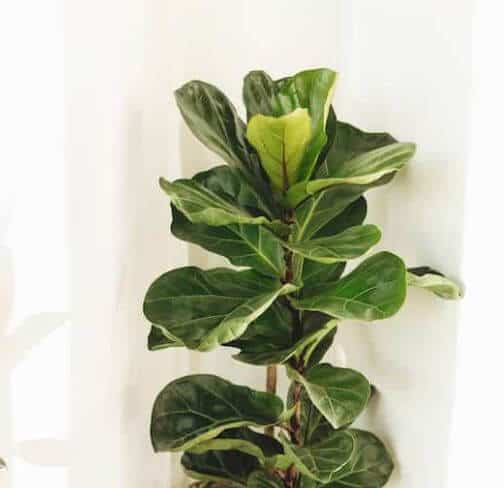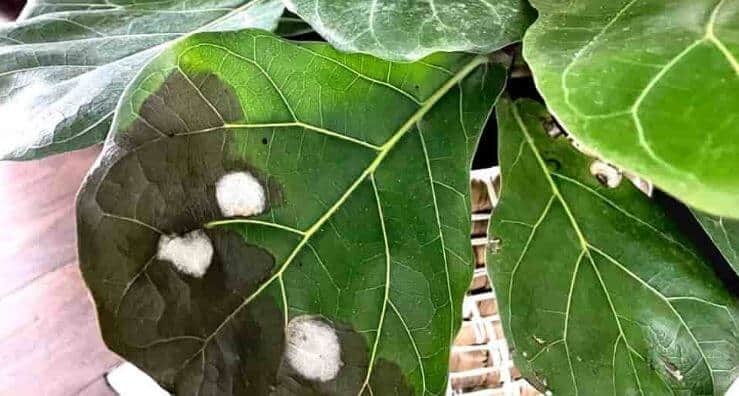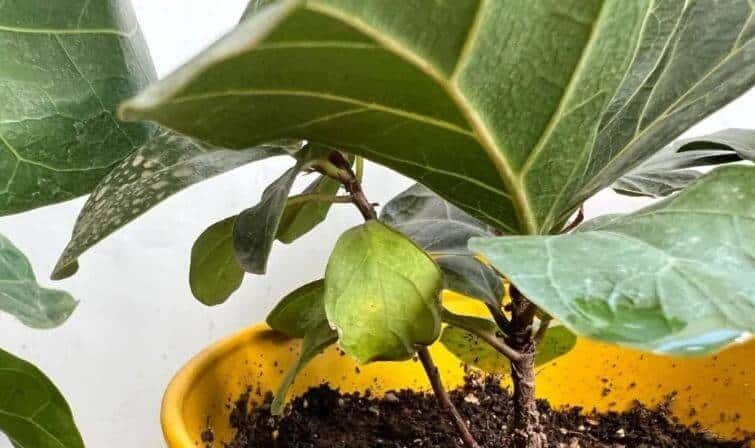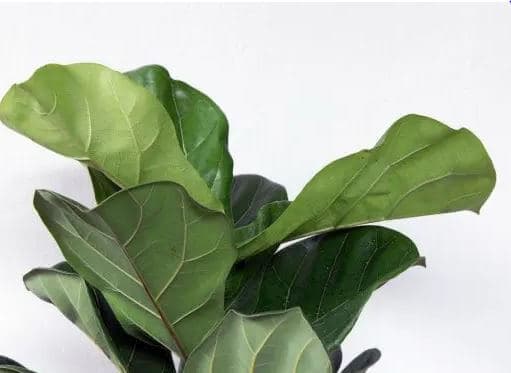Last Updated on May 30, 2023 by a Friendly Gardener
The popular Fiddle Leaf Fig indoor tree can be a bit of a diva when it comes to care with their most common problem being fiddle leaf fig leaf curl. Large, glorious violin-shaped leaves are glossy and heavily veined pointing upwards as they grow. Tree trunks are sleek. Ideal as floor plants, they require containers that can support indoor growth from six to ten feet tall.
Botanically known as the Ficus lyrate, these plants belong to the Moraceae family and are broadleaf evergreens. Commonly cultivated as houseplants, they can be grown outdoors in USDA hardiness zones 10 through 12 and can grow to heights of fifty feet.
Sensitive to any minimal change in environmental conditions, they can react negatively to overwatering or inadequate light levels. A common reaction to distress is fiddle leaf fig leaves curling. Curling can happen randomly or be directed either inward or outward. Leaf curling should be recognized as your plant communicating stress meaning you will need to intervene.
Why Are My Fiddle Leaf Fig Leaves Curling Up?

Here we have listed some of the most common causes of leaf curling and what to do to aid your plant.
Disease
Brown spots, yellow spots, and curling can all be indications of disease in the Fiddle Leaf Fig tree. These trees can be prone to bacterial or fungal infections.
For fungal infections like root rot, make sure your plant enjoys good air circulation and is not left to stand in soggy soil. Remove any infected leaves from the tree to prevent the spread and treat your plant with a fungicide like organic Neem oil if need be.
For bacterial infections, prune all infected leaves and try repotting your tree in fresh soil.
Environmental Temperatures
A native of western Africa, your plant prefers a warm climate so indoor temperatures should measure between 60° and 85°F. They should not be subjected to sudden changes in temperature or to drafts and should not be located near air conditioning or heating units and vents. Temperatures that drop below 60° or rise to over 85°F can cause leaf curling.
Excessive Feeding or Nutrient Imbalance

Your plant will benefit from fertilization during its growing season. Apply a fertilizer that is higher in nitrogen. Quality potting soil will also ensure the availability of adequate nutrients. If, however, you overfeed your plant leaves may begin curling. Should foliage become discolored shortly after fertilization and then begin to curl, you have overfed your plant and there is probably salt buildup in the soil bed.
Flush out the soil bed thoroughly and interrupt feeding for a couple of months.
Excessive Light

Fiddle Leaf Fig plants will enjoy a bit of direct light during the daytime; however, they respond better to bright, indirect light when cultivated as a houseplant. Generally cultivated for sale in nurseries inside greenhouses, they are not accustomed to direct sunlight exposure. Excessive exposure to direct sunlight, especially in hotter afternoon hours can cause leaf curl as the foliage begins to bend to conserve moisture and protect itself. Strong direct light will cause moisture evaporation to be more rapid.
Move your plant to a location where light is still bright but indirect and water it if the soil bed is dry. Leaves should begin to uncurl gradually.
Excessive Watering
When foliage curls downward, your fig tree may be telling you that you have overwatered. Like many houseplants, the fiddle Leaf Fog is susceptible to root rot when left in soggy soil. Foliage will wilt, begin curling and eventually fall off the tree.
If the soil bed is still moist, wait until the soil bed has dried at least halfway deep before watering. It’s a good idea to check your plant’s soil every couple of days.
Improper Drainage
Often confused with overwatering, a lack of proper drainage will afflict your plant in a similar way leading to leaf curling, leaf drop, and eventually root rot potentially killing the plant. Tree pots should feature lots of drainage holes so that any excess water freely drains out. The potting soil blend is equally important, as dense, heavy, and easily compacted soil can capture water in the root system impeding oxygen flow to roots.
If you suspect improper drainage, repot your tree in a container with more drainage holes and in fresh soil that is well-draining.
Insufficient Humidity
As a tropical plant, the Fiddle leaf fig tree is used to high humidity levels in its natural habitat. Not only will your tree want higher humidity levels, but it will thrive if humidity is constant. When indoor humidity levels are low, leaf edges may begin to brown, and leaves will curl.
Consider that this plant needs a minimum consistent level of at least 40% humidity year-round with 60% being closer to its preferred environment. If you live in an arid climate or use central air conditioning or heating, you may want to use a space humidifier or pebble tray. Grouping plants together and the occasional misting will help.
Pest Infestations
Fiddle Leaf Figs are no different than other indoor plants when it comes to bugs. They are particularly prone to infestations by mealybugs and spider mites, but fungus gnats and scale may also make an appearance. Peat damage, especially from sap suckers will cause leaves to suffer and curl and appear deformed.
Spider mites leave signs of webbing under foliage and between stems. Mealybugs leave cottony white deposits. Try showering your plant to remove some pests, then proceed to treat your plant with insecticidal soaps or spray with Neem oil.
Underwatering a Fiddle Leaf Fig Plant

Your Fiddle Leaf Fig also needs a soil bed that retains moisture. While the soil should never be soggy, underwatering is equally as damaging. Foliage may begin to droop and then curling upwards will follow. This is the plant’s attempt to conserve what moisture it has remaining.
How much and how often you water this plant will depend on a variety of factors like plant size and climate. Smaller plants may dry out faster, hence requiring more frequent watering. Mature trees have better water storage, so the soil bed can dry out completely before you water it anew. The weight of the pot will also provide an indication of how much moisture remains in the soil or you can purchase a moisture meter.
Water Quality
If you water your plants with city tap water, water quality may be a problem. Chemicals and minerals often found in municipal water systems can prove to be toxic. Chlorine is one such additive that when allowed to build up in the soil can burn root systems and cause leaf curling.
Try watering your plant with filtered or distilled water or collected rainwater.
A Final Thought

These are the most common causes of Fiddle Leaf Curling leaves. Most can be easily treated and your plant, given a little time, should return to normal. The most important thing is to correctly identify the cause to treat your plant and restore its health quickly.

